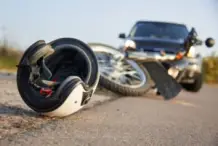
Motorcycle road rash is a common injury among riders, occurring when skin scrapes against the road surface during an accident. It ranges in severity from mild abrasions to deep wounds requiring extensive medical attention.
Understanding the degrees of road rash is crucial for riders and medical professionals alike, as prompt and appropriate treatment can significantly impact recovery outcomes. Let’s explore the different degrees of motorcycle road rash, their recognition, and recommended treatment approaches. If you’ve been injured, don’t wait to contact Laborde Earles now to speak with a Lafayette motorcycle accident lawyer.
The Different Degrees of Motorcycle Road Rash
One of the ways that motorcycle accidents differ from car accidents is their likelihood in causing road rash. Let’s take a look at the different degrees of road rash that can occur after a motorcycle accident:
First-Degree Road Rash
First-degree road rash is characterized by superficial skin abrasions with minimal bleeding. The affected area may appear red, swollen, and painful. Additionally, the skin is intact but may show signs of irritation or minor cuts.
If you have a first-degree road rash, you should clean the affected area with mild soap and water, followed by an antiseptic solution. Apply a sterile dressing and monitor for signs of infection.
Second-Degree Road Rash
Second-degree road rash involves deeper abrasions with partial skin loss. The affected area may bleed moderately, and the exposed tissue can be sensitive to touch. With this type of road rash, the skin will be broken, exposing the underlying layers, and there may be visible debris or gravel embedded in the wound.
If you have a second-degree road rash, clean the wound thoroughly to remove debris and foreign particles. Apply antibiotic ointment and a non-adherent dressing to promote healing. Seek medical attention if the wound is extensive or shows signs of infection.
Third-Degree Road Rash
Third-degree road rash is the most severe form, involving extensive tissue damage and full-thickness skin loss. The wound may expose muscle, tendons, or even bone, leading to severe bleeding and pain. This degree of wound appears deep, with significant tissue loss and exposed underlying structures. It may be accompanied by severe pain and bleeding.
Third-degree road rash requires immediate medical attention. Clean the wound gently to remove debris and control bleeding. Cover the area with a sterile dressing and seek emergency care for further evaluation and treatment, which may include debridement, skin grafting, and wound management.
Laborde Earles injury was great for me they took care of me very fast and professional. If for any reason I need legal help they will be who I use.
ClientRecognizing Complications of Road Rash Wounds
In addition to the degree of road rash, it’s essential to watch for potential complications that may arise during the healing process. These include:
- Infection: Road rash wounds are prone to bacterial infection due to exposure to dirt and debris. Watch for signs of infection, such as redness, swelling, increased pain, warmth, or pus drainage. Seek medical attention if infection is suspected.
- Tetanus: Motorcycle accidents can introduce tetanus-causing bacteria into the body. Ensure your tetanus vaccination is up to date, especially if you sustain a deep or dirty wound.
- Delayed healing: Factors such as age, overall health, and wound care practices can affect the healing process. Follow your healthcare provider’s recommendations for wound care and seek assistance if healing is delayed or complications arise.
I thank God for Digger & David. I don’t know what we would have done if it hadn’t have been for them.
Rick Smith | ClientSeeking Medical Attention for Road Rash
Seeking medical attention after experiencing road rash is crucial for several reasons. Take a look at some of the reasons here:
Assessing Injury Severity
Firstly, medical professionals can properly assess the severity of the injury and determine the appropriate treatment plan. They can identify any underlying damage to muscles, tendons, or bones that may not be immediately visible.
Thorough Cleaning
Secondly, medical care ensures that the wound is thoroughly cleaned and dressed to prevent infection. Road rash exposes the skin to bacteria and debris from the road surface, increasing the risk of infection if not properly treated.
Pain Management
Thirdly, medical professionals can provide pain management techniques to alleviate discomfort during the healing process. They may prescribe pain medication or recommend strategies such as wound care techniques and positioning to minimize pain and promote healing.
Ongoing Wound Monitoring
Finally, seeking medical attention allows for ongoing monitoring of the wound’s progress and any potential complications that may arise. Prompt intervention can prevent complications such as infection, delayed healing, or scarring, ultimately facilitating a smoother and faster recovery process.
Overall, seeking medical attention after a severe road rash ensures comprehensive care and optimal outcomes for the injury.
The reassurance from Digger and his staff gave me that renewed hope that it’s going to be okay down the road.
ClientAt-Home Treatment and Care
Proper treatment and care are essential for promoting healing and reducing the risk of complications associated with motorcycle road rash. Here are some general guidelines for taking care of your road rash at home:
- Clean the wound: Thoroughly clean the affected area with mild soap and water to remove dirt, debris, and bacteria. Use a gentle stream of water or saline solution to irrigate the wound and avoid scrubbing, which can cause further damage.
- Apply antibiotic ointment: After cleaning, apply a thin layer of antibiotic ointment to the wound to prevent infection and promote healing. Be sure to use a non-adherent dressing to protect the wound and minimize pain during dressing changes.
- Dressing changes: Change the dressing regularly according to your healthcare provider’s instructions. Monitor the wound for signs of infection or delayed healing and seek medical attention if needed.
- Pain management: Motorcycle road rash can be painful, especially during the initial stages of healing. Take over-the-counter pain relievers as directed by your healthcare provider, and use comfort measures such as rest and elevation to reduce discomfort.
They treated us like no other people would. Whenever we needed something they were there for us. I put my trust in them and I don’t regret it.
ClientNow You Can Recognize the Degrees of Motorcycle Road Rash
Motorcycle road rash is a common injury among riders, ranging in severity from mild abrasions to deep wounds requiring extensive medical attention. Understanding the degrees of road rash, recognizing potential complications, and following proper treatment and care guidelines are essential for promoting healing and reducing the risk of long-term complications.
By being aware of these factors and taking proactive measures, riders can better protect themselves and facilitate a smoother recovery process in the event of a motorcycle accident. Remember, if you’ve been injured in a motorcycle accident, contact the Laborde Earles Injury Lawyers now for legal help.





